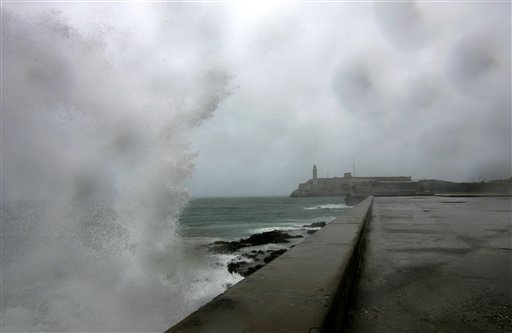With Hurricane Ike heading into the Gulf of Mexico, Texas
emergency officials stood ready Tuesday to order 1 million people
evacuated from the impoverished Rio Grande Valley and tried to
convince tens of thousands of illegal immigrants that they have
less to fear from the Border Patrol than from the storm.
CHRISTOPHER SHERMAN – Associated Press
McALLEN, Texas
With Hurricane Ike heading into the Gulf of Mexico, Texas emergency officials stood ready Tuesday to order 1 million people evacuated from the impoverished Rio Grande Valley and tried to convince tens of thousands of illegal immigrants that they have less to fear from the Border Patrol than from the storm.
Ike already roared across Cuba, ravaging homes, killing at least four people and forcing 1.2 million to evacuate Tuesday. It earlier pelted Haiti, killing at least 74.
Emergency planning officials in Texas were meeting all day to decide if and when to announce a mandatory evacuation for coastal counties close to the Mexican border.
With forecasts showing Ike blowing ashore in the U.S. this weekend, authorities lined up nearly 1,000 buses in case they are needed to move out the many poor and elderly people who have no cars.
Federal authorities gave assurances they would not check people’s immigration status at evacuation loading zones or inland checkpoints. But residents were skeptical, and there were worries that many illegal immigrants would refuse to board buses and go to shelters for fear of getting arrested and deported.
“People are nervous,” said the Rev. Michael Seifert, a Roman Catholic priest and immigrant advocate. “The message that was given to me was that it’s going to be a real problem.”
One reason for the skepticism: Back in May, Homeland Security Secretary Michael Chertoff said the Border Patrol would do nothing to impede an evacuation in the event of a hurricane. But when Hurricane Dolly struck the Rio Grande Valley in late July, no mandatory evacuation was ordered, and as a result the Border Patrol kept its checkpoints open. Agents soon caught a van load of illegal immigrants.
It would be the first mandatory large-scale evacuation in South Texas history. State and county officials let people decide for themselves whether to leave a hurricane area until just before Hurricane Rita struck the Gulf Coast in 2005. Now county officials can order people out of harm’s way.
At 8 p.m. EDT, Ike was about 95 miles west of Havana, Cuba, moving west-northwest at 10 mph with sustained winds near 75 mph. It was expected to cross the Gulf of Mexico, strengthening to a Category 3 with winds of up to 130 mph.
Forecasters said that it could hit Saturday morning just about anywhere along the Texas coast, with the most likely spot close to the Corpus Christi area.
Areas from Matagorda Bay to Corpus Christi and south to Brownsville – about 250 miles of coastline – were told to prepare for possible mandatory evacuation.
The Rio Grande Valley is still soggy from Dolly, which flooded the region, damaging hundreds of homes but killing no one. Many homes still have blue tarps on their roofs.
The Rio Grande Valley’s residents are among those least equipped to handle hurricane flooding. It is one of the poorest parts of the United States, with one-third of all families living below the poverty line, compared with 10 percent nationally.
Colonias, or ramshackle communities often lacking sewer systems and paved streets, dot the Valley. Even an ordinary rainstorm can fill yards with disease-ridden sewage from flooded septic tanks. Many of the poor lack health insurance.
Mexican officials said more than a dozen dams in the northern state of Chihuahua were at capacity or spilling over, heightening fears of flooding on the American side of the border.
Gov. Rick Perry declared 88 coastal counties disaster areas Monday to start the flow of state aid, and began preparing for an evacuation, lining up “buses rather than body bags.”
The Dallas-Fort Worth area sheltered about 3,000 Hurricane Gustav evacuees last week and is prepared for up to about 20,000 people this time, said Steve Griggs, a county official. The downtown convention center would again serve as the main shelter.
In Louisiana, where thousands remain without power after Hurricane Gustav hit last week, Gov. Bobby Jindal urged residents to start stockpiling food, water, batteries and other supplies. The state also was readying shelters and making plans for trains, buses and planes in case a coastal evacuation is called later in the week. Jindal said he doesn’t anticipate the sort of mass evacuations forced by Gustav, which emptied out most of south Louisiana, including the New Orleans area.
Associated Press writers Eileen Sullivan in Washington, April Castro in Austin, Texas, and Jeff Carlton in Dallas contributed to this report.













